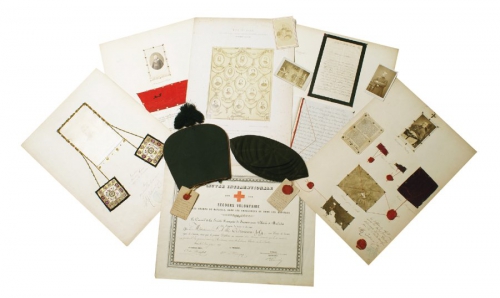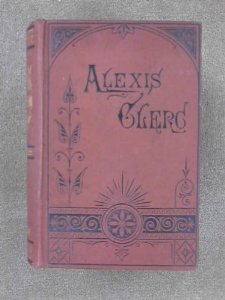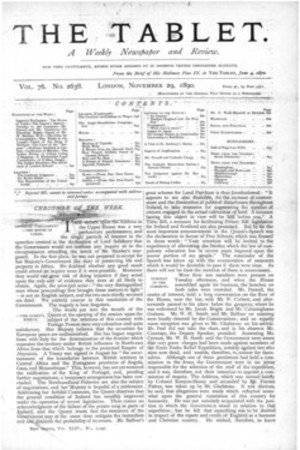12/07/2015
Emouvantes reliques
Nous venons d'apprendre qu'un lot de reliques des martyrs de la Commune a été mis en vente en Juin 2010.
A titre d'information nous reproduisons l'extrait du Catalogue concernant ce lot :
Émouvantes reliques des religieux martyrs de la Commune. 1871
Description
Émouvantes reliques des religieux martyrs de la Comune. 1871.
Grand carton relié demi-cuir, couverture en chagrin marquée « Reliques des martyrs de la Commune. 1871 » (traces de dorure). 55 x 37 cm
Il contient 44 grands feuillets cartonnés (44x34cm), présentant les reliques des prêtres exécutés durant la Commune de Paris, avec pour chacun, une photographie, un autographe, ainsi qu'un morceau de vêtement (soutane, chapeau ou gilet) souvent porté lors de l'exécution, le tout finement cousu.
Sont présentées les reliques de :
- L'abbé Allard, prêtre libre, aumônier d'ambulance : photographie, divers papiers lui ayant appartenus, autographes, fragment du chapeau porté lors de son exécution, allocution de l'abbé Allard, cousin du martyr, le 10 janvier 1872.
- L'abbé Bécourt, curé de Bonne Nouvelle : photographie, morceau de vêtement qu'il portait lors de son exécution, morceau de soutane, fin de son dernier sermon autographe.
- Le Père de Bengy, de la Compagnie de Jésus : photographie, morceaux de gilet de flanelle et de gilet teinté de sang, autographe.
- Le Président Bonjean, premier Président de la Cour d'appel de Paris : gravure, bout de papier percé de balles, teinté de sang, trouvé sur son cœur, autographes.
- Le Père Bourard, dominicain à Arcueil : photographie, morceau de gilet de flanelle, deux grains de chapelet, morceau de discipline, autographe.
- Le Père Captier, dominicain à Arcueil : photographie, morceau de soutane, autographe et illustration du massacre des dominicains d'Arcueil.
- Le Père Caubert, de la Compagnie de Jésus : photographie, morceau de gilet de flanelle, autographe.
- Le Père Chatagneret, dominicain à Arcueil : photographie, morceau de soutane et autographe.
- Le Père Clerc, de la Compagnie de Jésus : photographie, morceaux de mouchoirs teints de sang et de gilet de flanelle, autographe.
- Le Père Cotrault, dominicain à Arcueil : photographie, morceau de soutane et autographe.
- Monseigneur Darboy, évêque de Paris : photographie, morceaux de soutane, pardessus et de gilet teinté de sang, chemise percée de balles. L'ensemble scellé à la cire rouge de son sceau.
- L'abbé Deguerry, curé de la Madeleine : photographie, morceau de gilet teinté de sang, dernier billet autographe, morceau de soutane.
- Le Père Delborne, dominicain à Arcueil : photographie, morceau de soutane et autographe.
- Le Père Ducoudray, de la Compagnie de Jésus : photographie, morceaux de vêtement, autographes.
- Monsieur Guérin, otage de la Commune, scapulaire et autographe.
- L'abbé Houillon, prêtre de la congrégation des Missions étrangères : photographie, morceau de son mouchoir, autographes et sa calotte.
- Frère Néomède Justin : photographie, morceaux de robe et de manteau.
- L'abbé Olivaint, de la Compagnie de Jésus : photographie, morceaux de gilet de flanelle et de gilet teinté de sang, autographe.
- L'abbé Planchat, aumônier du Patronage de Sainte Anne, à Charonne : photographie, morceau du vêtement porté lors de son exécution.
- Le Père Radigue de la congrégation des S.C de Jésus et de Marie : photographie, morceau de vêtement et autographe.
- Le Père Rouchouse de la congrégation des S.C de Jésus et de Marie : photographie, morceau de soutane et autographe.
- L'abbé Sabatier, deuxième vicaire de Notre Dame de Lorette : photographie, morceau de vêtement porté lors de son exécution, autographes.
- L'abbé Seigneuret, séminariste de Saint Sulpice : photographie, morceau de vêtement et autographe.
- Monseigneur Surat, vicaire général de Paris : photographie, bout de vêtement, barrette, gravures, lettres et autographes.
- Le Père Tardieu de la congrégation des S.C de Jésus et de Marie : photographie, morceau de soutane et autographe.
- Le Père Tufier de la congrégation des S.C de Jésus et de Marie : photographie, morceau de soutane et autographe.
L'ensemble a été réuni par l'abbé Crétineau Joly, chaque pièce a été certifiée par des proches de chaque martyr et les feuillets sont tous revêtus du cachet des paroisses de Saint Germain des Prés, de La Madeleine ou de Notre Dame de Lorette. La correspondance de l'abbé avec les personnes ayant transmis les souvenirs, ainsi que des photomontages d'époque des différentes exécutions sont jointes à l'ensemble.
Historique :
Le 24 mai 1871, durant la “Semaine sanglante” , qui voit l'écrasement de la Commune de Paris par les troupes versaillaises, Monseigneur Georges Darboy, archevêque de Paris, l'abbé Gaspard Deguerry, curé de la Madeleine et célèbre prédicateur, trois pères jésuites et Louis-Bernard Bonjean, président de la Cour d'appel de Paris, qui avaient été faits prisonniers et retenus comme « otages du peuple de Paris », sont passés par les armes dans une cour de la prison de la Grande-Roquette. Différentes propositions d'échanges, notamment contre Blanqui, avaient été faites aux autorités versaillaises, en vain.
Les Pères dominicains, des professeurs et des domestiques du collège Albert le Grand d'Arcueil sont tués par balle, en pleine rue, le 25 Mai 1871 par les fédérés. Le 26 Mai, 5 ecclésiastiques et des gardes nationaux sont exécutés Rue Haxo. Enfin le 27 Mai, Monseigneur Surat et l'abbé Bécourt, bien que libérés de la Prison de la Roquette, sont pris à partie et tués en pleine rue.
19:31 Publié dans Actualités, Commune de 1871, Eglise catholique | Lien permanent | Commentaires (0)
08/11/2014
Ch. Daniel's book review
Voici une recension parue dans la revue The Catholic World (New York) de la traduction du livre du Père Charles Daniel, sj. Cela montre, s'il en était besoin, l'écho qu'ont eu à l'étranger les drames de la Commune et, plus précisément, le martyr du Père Alexis Clerc, dont toute la vie fut, depuis sa conversion jusqu'à sa mort héroïque, exemplaire.
Review
LIFE OF FATHER ALEXIS CLERC, S.J., SAILOR AND MARTYR. By Rev. Father Charles Daniel, S.J. New York : D. & J. Sadlier & Co. 1880.
We have read through this life of Father Clerc and have found it most interesting and edifying. It depicts the career of a man of our own day who had to contend with the most adverse influences, but who, being faithful to the inspirations of divine grace, overcame them all and obtained at last the martyr's crown.
Father Clerc reached the age of thirteen under the influence of a devoted and pious mother, but the religious impressions derived from her were soon smothered by the infidelity and hatred of religion prevailing in the state schools, to which he was sent by his father. After graduating at the Polytechnic he chose a career in the navy. For a little while he led a rather reckless life, like the rest of the midshipmen with whom he was thrown, but the sight of the heroism and self-sacrificing life of some French missionaries to the Gambier Islands in the South Seas aroused him to more noble thoughts, and then, after a long and difficult struggle of some years between these and the evil influence of former habits and irreligious companions, he finally emancipated himself from the slavery of vice and devoted himself henceforth to the service of God with his whole heart. He found his happiness in the exact performance of his duty as an officer, in studying the works of St. Thomas, and in the exercise of much prayer and communion with God. His piety was not sour or morose ; on the contrary, he appears to have been uniformly cheerful, and with a playful, innocent humor which made him a universal favorite with his associates in the navy. In this way he was the means of many conversions, and several of his companions, like himself, renounced their worldly prospects to devote themselves to a religious life.
The grace of God kept leading Father Clerc higher and higher, until, after ripe and mature deliberation, he came to the irrevocable determination to quit the navy and join the Society of Jesus. Then he practised for some years the virtues of humility and obedience in a way to edify all his companions, though hidden from the eyes of the world. God, as a reward for his faithfulness, selected him for martyrdom. He was shot, in company with the Archbishop of Paris and other eminent ecclesiastics, by the Communists in their rage when the city of Paris was taken from them. One cannot peruse this life without being strongly moved to follow Father Clerc's example. Father Daniel has faithfully collected the incidents of his life, many of his letters and the testimonies of the friends who knew and loved him, and has thus given us a most interesting biography which will well repay any one who will read it.
THE CATHOLIC WORLD.
A Monthly Magazine of General Literature and Science
Vol. XXXII. October, 1880, to March, 1881,
(pp. 719-720)
New York: The Catholic Publication Society Co., 9 Barclay Street, 1881.
Copyright, 1880, by I. T. HECKER.
Source:
https://archive.org/stream/catholicworld32pauluoft#page/n3/mode/2up
16:03 Publié dans Actualités, Bibliographie | Lien permanent | Commentaires (0)
Recension d'une biographie en anglais
Nous vous proposons ici une recension du livre de Lady Mary Elizabeth HERBERT consacré au Père Alexis Clerc et publiée à Londres, en 1890, sous le titre suivant : A Martyr from the Quater Deck.
Cette recension est parue dans le journal anglais The Tablet, dans le numéro du 29 novembre 1890.
The Tablet
Page 14-15, 29th November 1890
A MARTYR FROM THE QUARTER DECK.[*]
LADY HERBERT'S busy pen has contributed to Father Coleridge's Quarterly Series a touching and edifying volume entitled as above. The Christian hero of this tragic narrative is Alexis Clerc, a converted agnostic of our own day, and the merit of this book is its special suitableness to these "dangerous times" in which we live. Its pages set forth, not the theory, but a brilliant example of conversion of heart from the agnosticism which is now making such havoc among this generation. The life of Alexis may be divided into three periods, (1) his wandering from God into unbelief, (2) his happy return to God and His holy laws, (3) his subsequent years as a layman and a priest, until, in 1871, he gloriously died a victim of expiation.
Alexis was formed by his mother to faith and purity. In his childhood he loved to read the lives of the saints, to whose imitation he aspired. But his good mother's influence was counteracted by the evil influence of his free-thinking father, who sent him at an early age to an infidel school in Paris. There the Catholic instincts imbibed from his mother were soon stifled by inhaling the poisonous atmosphere of a hotbed of infidelity. But though his mind was perverted by agnostic philosophy, yet he never fell so far down the abyss of evil as to fly from God with secret aversion and madness, which is the case with so many infidels of our day. Yet for many years Alexis "sat in darkness and in the shadow of death," leading a life of vanity illusion, and pride, measuring good and evil, not by the light of truth, but by the, cravings of passion. While thus alienated from God, a religious book fell into his hands which raised a suspicion in his unhappy soul that perhaps after all there was a deadly poison hidden in the cup of pleasure which he was drinking. The suspicion aroused the powers of his soul, which had not found in earthly enjoyment the rest and happiness that he had sought.
He thereupon betook himself to the serious study of Christianity, analysing its doctrines and examining its traditions, which resulted in his intellectual conviction of the truth of revelation. For a time his will held back from embracing Christianity, which he was content to regard as a grand abstraction. But little by little the light of grace streamed into his soul. He began to understand God's goodness, power, and majesty, and the madness of daring to violate His divine laws. His will was then moved to repentance and compunction of heart, and the miracle of his conversion was complete—a conversion which was specially remarkable for its thoroughness. For not satisfied with publicly glorying in his faith, in spite of the jeers and ridicule of his shipmates, he made it henceforth his chief study to reduce to practice the gospel teaching of our Lord, Whom he now acknowledged as his only Master. To this practice heattained in an eminent degree by prayer, penance, and the study of divine things, which he found time for in the midst of his life in the navy. His favourite study, even when a layman, was the Summa of St. Thomas, by which he trained his mind and conscience and raised himself to a high standard of Christian perfection. He thus became an instrument God's hands for the conversion of many of his comrades on the quarter-deck.
Having gone up the ladder of perfection step by step he at length renounced, not only the spirit of the world, but the world. itself by entering the Society (4 Jesus and becoming a priest, and his saintly life won for him from the King of Martyrs the privilege of a martyr's crown. We will not dwell on the exciting story of his martyrdom in the midst of the atrocities ot the Paris Commune. We will merely mention that during his cruel imprisonment at Mazas he was sustained in his solitude and sufferings, as the martyrs were of old, by the possession of the Blessed Sacrament and the Holy Scriptures. For by a pious stratagem the Blessed Sacrament was brought to him in prison, and he bore It on his breast as a living altar. So great was the transport of his inward joy at possessing our Lord with him that he said to a friend Who went to see him: "I am no longer solitary in my cell, for my Lord and my God has come to share it with me. It is not only in thought that I can draw near to Him, but in very deed and in truth. He is come corporally to console His poor prisoner. He wills to keep me company." His friends also at his entreaty brought him a copy of the Holy Scriptures, which gave him such comfort that he was heard to say that with the Bible he had enough to nourish his soul during all the time he should remain in prison, even were he to die of old age.
In concluding. this hasty notice we strongly recommend our readers to read the martyr's life, for we feel sure that they could find nothing that would better serve as a Christmas faggot to kindle in their souls the fire which burns so languidly in these latter days when faith is extinguished in many souls, and the charity of so many has grown cold.
Source:
http://archive.thetablet.co.uk/page/29th-november-1890/14
http://archive.thetablet.co.uk/page/29th-november-1890/15
15:50 Publié dans Actualités, Biographie | Lien permanent | Commentaires (0)






